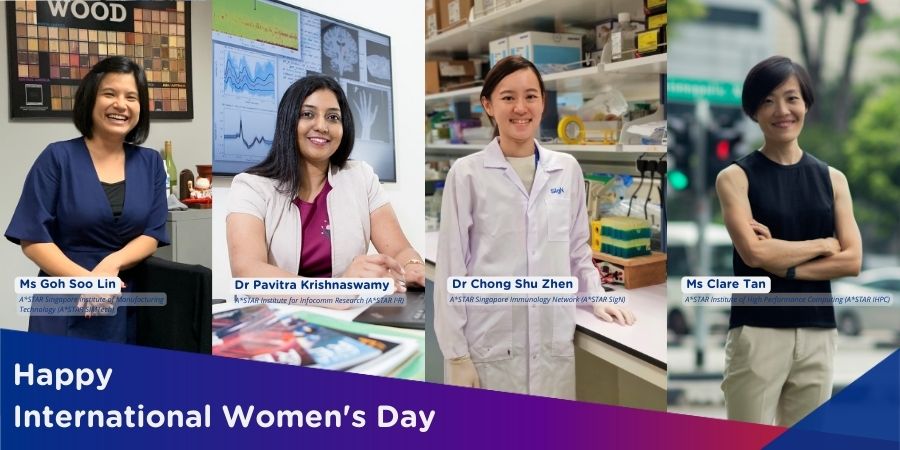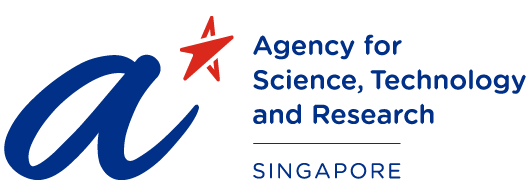A*STAR NEWS
Grasping The Trend: Chip Wars Escalate In The AI Era, Singapore's Semiconductor Sector Emerges Strong
Singapore occupies a pivotal position in the global semiconductor supply chain. One in every 10 chips worldwide is manufactured locally, while our semiconductor equipment output accounts for one-fifth of the global total. As we enter the artificial intelligence (AI) era, the volume of data requiring processing is growing exponentially, and demand for speed is increasing rapidly. Can Singapore develop world-class semiconductor companies in emerging technological fields and secure global leadership? Beyond AI, local semiconductor firms are also targeting opportunities in data centres, electric vehicles, the Internet of Things (IoT), and 5G.

Source: Lianhe Zaobao © SPH Media Limited. Permission required for reproduction
The geopolitical competition between the United States and China has transformed semiconductor chips into a fiercely contested battleground. It seems almost inconceivable now, but less than a decade ago, Singapore's semiconductor sector—which now supports a substantial portion of the nation's economy—was once considered a sunset industry.
Reflecting on Singapore's semiconductor industry development in an interview with Lianhe Zaobao, Mr Ang Wee Seng, Executive Director of the Singapore Semiconductor Industry Association (SSIA), recalled: "Before 2018, when I delivered talks at schools to encourage young students to join our industry, fewer than 10 people would attend each session."
Everything changed dramatically when Donald Trump became President of the United States. Shortly after taking office in 2018, Trump imposed tariffs on semiconductors imported from China, igniting a technological rivalry between the United States and China that has only intensified since.
The global COVID-19 outbreak in 2020 further underscored the importance of these tiny chips. According to estimates by consulting firm AlixPartners, the global automotive industry was compelled to reduce production by 7.7 million vehicles in 2021 due to chip shortages, resulting in losses exceeding US$200 billion (approximately S$261 billion).
Global players diversify production to manage risk, Singapore's semiconductor industry contributes nearly 6 per cent of GDP
With the US-China rivalry and the pandemic serving as stark warnings, global semiconductor players began further diversifying their risks by expanding production across multiple regions.
For instance, Taiwanese chip manufacturer Vanguard International Semiconductor (VIS) and Dutch semiconductor company NXP Semiconductors are jointly investing approximately S$10.5 billion to establish a 12-inch (300mm) wafer fabrication facility in Singapore. Groundbreaking commenced in December last year, with the facility expected to begin mass production in 2027.
NXP is a leading supplier of automotive chips. According to International Data Corporation (IDC), NXP commands nearly 11 per cent of the global market share, ranking second worldwide.
A spokesperson from the Singapore Economic Development Board (EDB) told Lianhe Zaobao: "Singapore serves as a critical node in the global semiconductor supply chain. One in every 10 chips worldwide is produced in Singapore. Singapore also accounts for one-fifth of global semiconductor equipment output. Over the past two years alone, the local semiconductor sector has successfully attracted more than S$18 billion in R&D and manufacturing investments."
As of 2023, the semiconductor industry contributed nearly 6 per cent to Singapore's Gross Domestic Product (GDP) and employed more than 35,000 people.
According to the Macroeconomic Review recently released by the Monetary Authority of Singapore, 16.6 per cent of Singapore's exports to the United States last year were semiconductor-related. Semiconductor products currently fall outside the scope of the US base tariff regime, but Trump is considering imposing targeted tariffs on products in this sector. The potential impact on Singapore's semiconductor industry remains uncertain, but the sector's strategic importance to Singapore is indisputable.
This represents the culmination of nearly 60 years of accumulated growth and development. In 1968, United States’ National Semiconductor Manufacturing became the first company to invest and establish a facility in Singapore, introducing semiconductor technology to the newly independent nation. Soon after, other major players including Fairchild Semiconductor, Texas Instruments, Infineon, and Philips followed suit, establishing operations focused on assembly and testing.
During the 1970s, as American semiconductor companies began outsourcing substantial portions of their manufacturing to Asia, Singapore emerged as one of the principal beneficiaries of this economic transformation.
Mr Ang Wee Seng observed: "One of the key strengths of this industry is its capacity to nurture a large pool of skilled professionals. By the 1980s, Singapore began moving up the value chain. The establishment of Chartered Semiconductor Manufacturing gave us our first wafer fabrication facility."
With support from the Economic Development Board, Chartered Semiconductor Manufacturing was formed as a joint venture between Temasek Holdings’ Singapore Technologies, Sierra Semiconductor, and United States’ National Semiconductor Manufacturing. It once ranked as the world's third-largest wafer foundry and was listed on both US and Singapore exchanges. However, after suffering consecutive years of losses, it was acquired by GlobalFoundries in 2009 for US$1.8 billion, with GlobalFoundries also assuming Chartered Semiconductor Manufacturing's US$2.2 billion debt burden.
AI raises the bar for chips, opening new technological frontiers
In the Global Value Chain Development Report 2023, the World Trade Organization featured a section titled “Singapore’s Chartered Semiconductor Manufacturing and Failed State-Led Catching up”, specifically examining Chartered Semiconductor Manufacturing's development trajectory. The report noted that Singapore lacked a critical mass of chip design companies and sufficient downstream demand—factors that placed tremendous profitability pressure on Chartered Semiconductor Manufacturing from the late 1990s onwards.
Chartered Semiconductor Manufacturing's acquisition and delisting marked a setback in Singapore's ambition to independently develop advanced chip manufacturing capabilities.
Currently, the most advanced chip manufacturing technology available locally is the 22-nanometre process, offered by a new wafer fabrication facility built with a US$5 billion investment by United Microelectronics Corporation (UMC), Taiwan's second-largest chipmaker. The new facility commenced operations in April this year. For reference, 1 nanometre is one hundred-thousandth the width of a human hair.
International semiconductor industry association SEMI represents 3,000 semiconductor companies worldwide and is headquartered in the United States.
In an interview, Ms Linda Tan, President of SEMI Southeast Asia, explained: "Singapore has not produced a 'national champion', but that doesn't signify failure. Our policy has consistently focused on creating an environment conducive to investment, innovation, and talent development, positioning Singapore as an integral component of the global supply chain."
Although Singapore's semiconductor sector is currently dominated by multinational corporations, Professor Yeo Yee Chia, Deputy Chief Executive at the Agency for Science, Technology and Research (A*STAR), shared in an interview: "These multinationals are battle-tested. They have extensive mass production experience and a deep understanding of future market needs, and can provide us with the latest industry insights. A*STAR's research must be forward-looking. If something is already in mass production at factories, there is not much value we can add. Our focus is definitely on technologies that can achieve commercial viability within the next three to five years."
The focus for the next three to five years would be on artificial intelligence (AI) and its related technologies. Prof Yeo explained: "More powerful AI systems in future will require memory chips with greater capacity and processors with higher performance. These two chip types must be integrated using highly advanced packaging technologies, enabling massive volumes of data to transfer between processing and storage. This is what we usually mean by ‘training’."
"But that's insufficient. The integrated chips must also be energy-efficient. Essentially, we want the horse to run fast while consuming minimal feed," he added, using a Chinese saying to describe the need for high performance with low power consumption.
Currently, chip signal transmission relies on metal wiring. "In future AI systems, data transmission over longer distances will be optical rather than electronic, because extensive wiring consumes too much power,” said Prof Yeo.
What Prof Yeo was describing is silicon photonics—a technology as critical as advanced packaging for the future of AI and data centres.
To ensure stable power supply, some US companies are even constructing small nuclear power plants adjacent to their data centres. "That's not viable for Singapore," Prof Yeo noted. "If we wish to continue building data centres, we must rely on light."
A*STAR spinoff takes on Intel, 100 per cent focused on silicon photonics
Can Singapore leverage these two technologies—advanced packaging and silicon photonics—to build a world-class semiconductor company comparable to United States’ Intel, Taiwan’s TSMC, or South Korea’s Samsung? "It's not impossible, but it has its share of challenges," said Prof Yeo. "It requires sustained investment and cannot depend solely on government support. This industry is extremely competitive. If one lacks genuine ambition, don’t even try."
Founded in 2017 as an A*STAR spinoff, Advanced Micro Foundry (AMF) may represent Singapore's best bet. Its CEO, Mr Jagadish CV, highlighted that Intel is currently the leader in silicon photonics. "Our competitor is Intel. You could even say we are the TSMC of this emerging field."
AMF develops its own intellectual property (IP). Customers can utilise AMF's design tools to create their own chips, which are then manufactured at AMF's wafer fabrication facility—a business model similar to TSMC's. Mr Jagadish added candidly: "TSMC is a company with tens of billions in annual revenue. We haven't even reached S$20 million, so naturally we cannot compare. But I can say this: there is no other company globally like us, which is 100 per cent focused on silicon photonics."
Besides data centres, Mr Jagadish noted that telecommunications, large language models, quantum computing, and augmented and virtual reality all stand to benefit from silicon photonics.
According to semiconductor consultancy Yole Group, the silicon photonics market was valued at merely US$95 million in 2023, but is projected to reach US$863 million by 2029, representing a compound annual growth rate of 45 per cent.
Additionally, consultancy firm McKinsey forecasted that advanced packaging, driven by end-use sectors including industrial, automotive, and mobile devices, will expand from US$2.42 billion in 2020 to US$8.69 billion by 2026.
Mr Jagadish expressed hope that Singapore's semiconductor sector could evolve into a vibrant ecosystem akin to Silicon Valley—one that brings together startups and cutting-edge R&D. "Perhaps 20 years ago this was unthinkable. But today, many small Singaporean firms are willing to stake their future on semiconductor technologies and compete globally."
Homegrown chip design firms target electric vehicle market
Despite earning a comfortable salary and stock options from multinationals—which he believes is sufficient for the rest of his life—Mr Lim Kok Chiang founded chip design company MPics Innovations five years ago, as he did not want his accumulated knowledge to go to waste.
Mr Lim, one of Chartered Semiconductor Manufacturing's early employees, had been sent to Silicon Valley for two years of training—making him part of the first generation of semiconductor professionals nurtured in Singapore.
Over the past three decades, Mr Lim Kok Chiang has worked for several multinational chip design companies. The firm he founded, MPics Innovations, specialises in chip design for drivers, power management, and sensors, targeting the electric vehicle (EV) market.
In an interview with Lianhe Zaobao, Mr Lim shared: "This is an extremely challenging market to penetrate. But once you're established, it provides stability—a single vehicle can operate for at least 10 years, and the market won't vanish overnight like consumer electronics."
MPics develops analog and radio frequency (RF) chips. Mr Lim emphasised that US and European companies dominate this field, but Singapore's talent pool—after years of training—also maintains a competitive advantage.
"When we were at Broadcom, we partnered with a Japanese firm. Their requirement was zero defective parts per million (DPPM), and they understood this was practically impossible.”
"In our first year, our DPPM was 100. My team travelled to Japan monthly to apologise and explain our situation. After approximately three to four years, we reduced it to just 3 DPPM, and they finally accepted us. That represents the kind of expertise we've developed."
SEMI Southeast Asia President Ms Linda Tan noted that analog and RF chips form the foundation for applications in automotive, the Internet of Things (IoT), 5G, and industrial automation. "In Southeast Asia, particularly Singapore, demand in these sectors is exceptionally strong."
Three sectors to drive 70 per cent of growth, global market to achieve 7 per cent CAGR over 10 years
According to McKinsey’s projections, the global semiconductor market is expected to reach US$1.06 trillion by 2030, with a compound annual growth rate (CAGR) of 7 per cent over the next decade. Approximately 70 per cent of this growth will be driven by automotive, computing and data storage, and wireless communications.
Mr Ang Wee Seng, Executive Director of the SSIA, noted that TSMC attracts significant attention due to its success in developing 3-nanometre process technology, which enables mass production of the most advanced logic chips—such as the processors used in iPhones and graphics processors by NVIDIA.
Mr Ang explained: "If you examine the global market, there are many sectors where demand is growing rapidly, but these are areas that TSMC focuses on less because its equipment is simply too expensive and production costs are too high. It's like driving a Mercedes-Benz while being restricted to 20 km/h, it doesn't play to its strengths."
In recent years, the SSIA has actively promoted stronger collaboration between local institutes of higher learning and industry players to enhance chip R&D and design capabilities. A*STAR’s Deputy Chief Executive Prof Yeo supports this initiative: "This is a high-margin industry. Apple and NVIDIA are both world-class chip design companies."
However, Mr Ang stressed that manufacturing remains at the heart of Singapore's semiconductor industry, and is a critical pillar in the nation's Manufacturing 2030 vision. Many multinational semiconductor companies have expanded their Singapore operations in recent years. For example, Micron Technology is investing US$7 billion to build Singapore's first advanced packaging facility for high-bandwidth memory (HBM). GlobalFoundries is investing US$4 billion to expand its fabrication facilities. Siltronic, a German silicon wafer manufacturer, is investing S$3 billion to build a third wafer fabrication facility in Singapore.
President of SEMI Southeast Asia, Ms Linda Tan, believes Singapore plays a pivotal role in the global semiconductor value chain. "In recent years, the global semiconductor industry has undergone major transformations. The tariffs introduced by Trump and the COVID-19 pandemic exposed global supply chain vulnerabilities. This prompted companies to prioritise resilience over cost. Consequently, we now observe increasing expansion into different regions, with strategies like 'friendshoring' and dual-sourcing gaining prominence."
"For Singapore, these adjustments have created significant opportunities. Our stable business environment, trusted regulatory framework, and well-developed semiconductor ecosystem have positioned us as a natural choice for companies seeking reliable supply chains in Asia."
Mr Lim Kok Chiang shares this perspective but sounds a cautionary note regarding chip design. "We have only three to five years. Once other parts of Asia achieve technological parity, we'll lose this opportunity."
Fortunately, Singapore's semiconductor industry is experiencing a renaissance—and interest is surging. Mr Ang Wee Seng shared: "Now when I deliver school talks, at least two full classes of students attend every session."
This coming Tuesday, 20 May, Singapore will host SEMICON Southeast Asia 2025.
The three-day exhibition is expected to bring together over 600 international and local companies, attracting between 15,000 to 20,000 participants.
Source: Lianhe Zaobao © SPH Media Limited. Permission required for reproduction
Was This Article Helpful ?
A*STAR celebrates International Women's Day

From groundbreaking discoveries to cutting-edge research, our researchers are empowering the next generation of female science, technology, engineering and mathematics (STEM) leaders.
Get inspired by our #WomeninSTEM




